2017 Suzuki GSX-R1000R review: the beauty of Gex
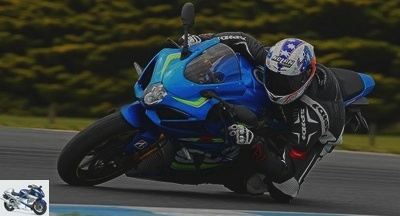
Driven by the most recent hypersport motorcycles for lack of developments in the last ten years or so, Suzuki is tightly contracting the muscles to regain pole position with its new 2017 GSX-R1000. MNC tested its top-of-the-range version, the GSX-R1000R, on the sumptuous circuit of Phillip Island (Australia). Test !
GSX-R 1000 test page 3 – MNC technical point
Engine
Suzuki started from scratch, or almost, to design the new inline 4-cylinder for the 2017 GSX-R1000, which had not happened since 2009. The 999.8 cc (+0.7 cc Vs 2016), shorter by 22.2 mm and narrower by 6.6 mm, adopts even more super-square dimensions (76 x 55.1 mm Vs 74.5 x 57.3 in 2016) to deliver more power at high speeds.
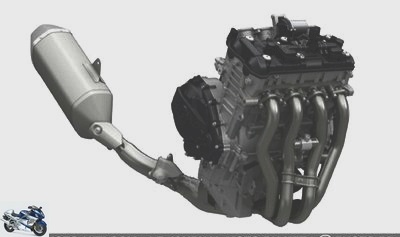
The compression ratio increases from 12.9: 1 to 13.2: 1. The gain is spectacular: 202 cannons now gallop at 13,200 rpm, against 185 hp previously (+ 17 hp). This increase can be explained, among other things, by the raising of the maximum speed to 14,500 rpm at the switch, against 13,500 in 2016 (+ 1,000 rpm). This significant improvement replaces the 2017 GSX-R1000 at the level of current Superbikes which approach or exceed 200 hp, a threshold that has become the standard today (192 hp for the 2017 CBR, 199 hp for the R1 and S1000RR, 200 hp for the ZX-10R). The Ducati 1299 Panigale with its 205 hp, however, retains the palm of raw power !
To channel all this enthusiasm and avoid the panic of the valves (possible risk at such high speeds), light pawls now actuate the 16 valves (6 g gained compared to pushrods), now in titanium and no longer in stainless steel. exhaust. This technology derived from Formula 1 appeared in the category for the first time in 2009, on the BMW S1000RR. Therefore, the camshafts for the GSX-R are new. Another first on a GSX-R: the use of a ride-by-wire, replacing the good old accelerator cable.
However, torque is not sacrificed on the altar of power to the breaker, since the 2017 Gex claims 117.6 Nm at 10,800 rpm against 116.7 Nm in 2016. A very correct torque value in the category. To achieve this, a new technology is emerging: a sophisticated variable valve timing VVT (Variable Valve timing), capable of adjusting the valve lift time to a predetermined speed..
Suzuki variable valve timing: a first for a production sports car
This technology, used for the first time on a production sports motorcycle, has been developed by Suzuki for ten years in MotoGP, first on the GSV-R with V4 engine and then on the current GSX-RR with 4-cylinder in-line. This Suzuki Racing-VVT (SR-VVT) is based on a mechanical system made up of 12 balls placed in the intake camshaft gear, in inclined grooves.

With the centrifugal force, these steel balls are progressively pressed towards the outside of the pinion at 10,000 rpm, which slows down its rotation and consequently delays the advance when opening the intake valves. The intake diagram is thus optimized at all speeds, allowing – on paper – to release torque at low speeds and power in the revs. All while consuming less fuel !
This type of device is very rarely used in motorcycle production, because of its cost, its size, its overweight but also its not always convincing efficiency … Let us mention in particular the V-Tec system introduced by Honda on its VRF800 or the Variable timing system (VVT, too) on the Kawasaki GTR1400. Test shots remained unsuccessful: neither Honda nor Kawasaki installed it on other motorcycles, which reflects a certain imbalance between advantages and disadvantages…
More recently, Ducati has developed its own system and installed it on its Multistrada 1200s. With success this time, since the DVT (Ducati Variable Timing) really brings flexibility to the Italian twin, which is indeed quite sober compared to its displacement. Suzuki says for its part that its VVT does not take up additional space and does not weigh down the engine, because it is mainly composed of already existing parts..
Furthermore, Japanese engine manufacturers ensure that the distribution transition is imperceptible, since the centrifugal force increases gradually. "Since its development began ten years ago, MotoGP riders have never been able to sense or sense when the system changes." Something to reassure those who fear a "turbo" effect as on the VFR800 V-Tec, moderately compatible with the precise dosage required in sporty driving !
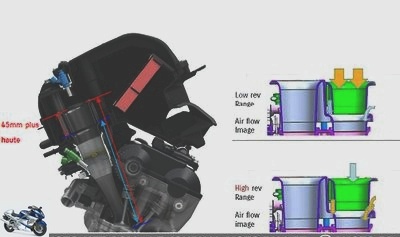
As on the previous generation, the 4-cylinder of the Gex is powered by two 10-hole injectors: one placed in the intake body (both shorter and wider), the other located at the top of the the air box. The latter is set in motion only at high speeds. Admission is also via two-tier pipes, separated by a space.
At low and medium speeds, the mixture is sucked in by the highest part of the pipe, for the benefit of the couple. Then, at high speeds, it tries to slip in as quickly as possible under the effect of the increased suction: the gas mixture then spins into the vacant space located between the two pieces, in favor of the power. A kind of variable intake, without the overweight induced by a system of sliding trumpets !
The exhaust – titanium – of the new GSX-R1000 also evolves thanks to the Suzuki Exhaust Tuning-Alpha (SET-A) system. A tube connects the manifolds of cylinders 1 and 4 and another connects cylinders 2 and 3 in order to increase power at low and medium speeds. The valve of each tube opens via a servo motor to increase the volume of gas at high speed, in favor of the power, and thus to reduce the pressure.
No big bang at Suzuki
If Suzuki was inspired by its competitors to develop its new engine (super square and ride-by-wire dimensions as on the Aprilia RSV4, MV Agusta F4 and other Panigales, latches as at BMW, etc.), the coat of arms of Hamamatsu, however, was careful not to copy everything en bloc. Thus, the crankshaft rotation of the 2017 GSX-R1000 remains traditional, and not reversed as on the MV Agusta or the GSX-RR from MotoGP..
Likewise, the Suzuki Superbike retains a 4-cylinder with Screamer timing, i.e. with explosions every 180 ° in pairs of cylinders, and not an irregular timing called Big Bang as on the GSX-RR … and the Yamaha of Grands Prix (M1) and series (R1), under the name Cross Plane! This is why the 2017 GSX-R1000’s block doesn’t deliver a sound as rocky as its MotoGP alter ego, which evokes a low V4 in the towers..
The reasons given to justify this choice are the additional vibrations generated by asynchronous setting, but also the obligation to use heavier housings. In the end, the additional cost was not up to the benefits expected for a production motorcycle, say Suzuki engine manufacturers. Engineers also mentioned an increase in internal temperature leading to a risk of overheating …
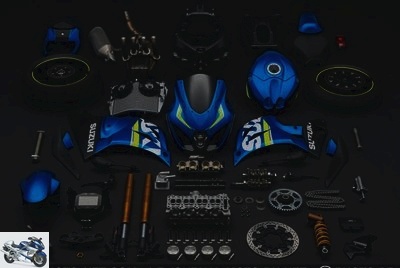
The argument does not lack sense insofar as the R1 Cross planes indeed releases a lot of calories! Too much even, in view of its problems encountered in the past in Endurance. However, after reading this technical point, we can measure all of the research carried out by Suzuki to get back into the race, while retaining the character traits appreciated on its legendary Gex (mechanical roundness combined with the ardor in the towers).
The 2017 GSX-R1000 also adopts a clutch system in oil bath with limited slip and a shortened final transmission to favor the revivals (525 steps Vs 530 in 2016). Its six-speed gearbox is now removable, a device resulting from the race which facilitates its removal. The cooling circuit has also been optimized to withstand the new constraints: a second fan appears behind the new high-performance radiator, while the cylinder head cooling circuit is redesigned..
Finally, note that the mechanical performance is identical between the two versions of GSX-R. The more sophisticated and better equipped GSX-R1000R does not have specific injection mapping, as Honda did on its new CBR1000RR for example.
Cycle part
By reducing the inclination of the cylinder bank by six degrees, Suzuki managed to contain the footprint of its 22.2 mm engine on a horizontal plane. And who says shorter engine says possibility of shortening the front part of the frame (- 20 mm), which offers two positive aspects: bringing the center of gravity closer to the front wheel in order to improve the feeling, but also to be able to lengthen the arm. oscillating to promote motor skills (+ 40 mm).

The perimeter-type aluminum frame takes advantage of the thinning of the 4-cylinder to reduce its width by 20 mm. Some of the front side reinforcements are removed to lower the weight by 10%, without losing rigidity according to Suzuki. The redesigned rear buckle displays for its part 1 kg less on the scale, which contributes to the total gain of 3 kg displayed compared to the previous Gex: 202 kg Vs 205.
Note that the new GSX-R1000R shows its side 203 kg, or 1 kg more than the standard version. The reason for this difference is due to its additional equipment, such as its double-acting shifter (up and down gears), absent on the GSX-R1000 "short".
In terms of geometry, the GSX-R1000 has a slightly increased wheelbase (1410 mm Vs 1405 in 2016), mainly due to the extension of the new swingarm required to pass all the additional power to the ground. To compensate, the front axle closes in order to save maneuverability: the caster angle reached 23.2 ° against 23.5 ° in 2016, while the frame is reduced to 95 mm (98 mm in 2016).
The electronic steering damper released in 2009 continues to fight against any inclination of the steering to guide, without freezing it at low speed. Honda has successfully used the same type of system on its CBR1000RR for several years. Also of note is the redesigned tank, 21mm lower for a better position on the bike, as well as the narrower 16mm fairings at their widest point..
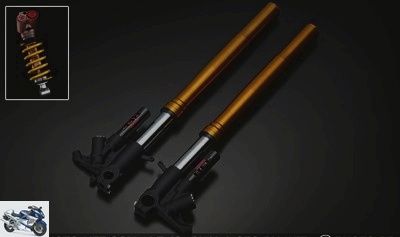
In terms of damping, both versions of the 2017 GSX-R1000 call on Showa. On the base GSX-R1000, the fork is a so-called Big Piston Showa BPF, fully adjustable. The rear suspension is based on a mono-shock absorber fixed on rods, also adjustable in preload, rebound and compression (high and low speed). Excellent gear, present in particular on the latest generation of CBR1000RR (yes, again!).
On the more racing version GSX-R1000R, the quality of the suspension takes a further step towards performance with a Showa BFF Balance Free Front fork, recognizable by its separate bottles located on the fork legs. This fork is also fully adjustable and is used in particular on the latest ZX-10R. At the rear, the GSX-R1000R receives a Showa BFRC lite monoshock, whose operation is more fluid thanks to its separate cylinder, as for the fork.
The improvement in damping is so significant that it would no longer even be necessary to "provide separate compression settings at high and low speeds and therefore the shock is lighter," says Suzuki. What clears the absence of electronically controlled suspensions, in vogue on the latest sports cars ?
The pneumatic assembly is entrusted to the very efficient Bridgestone RS10 on the two versions of the GSX-R1000, replacing the S20 of the previous generation. The dimensions do not change significantly – the sidewall height simply goes from 50 to 55 – and remain within current standards: 120/70/17 and 190/55/17.
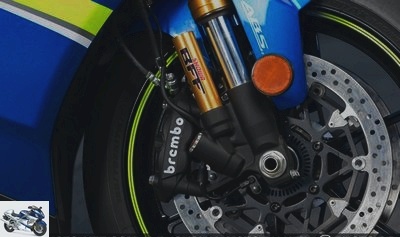
In terms of braking, both versions are fitted with one-piece Brembo radial-mount calipers. These clamps, identical to those of the 2016 vintage (the Gex switched to Brembo and ABS in 2015) are however installed on larger diameter discs (320 mm Vs 310 in 2016). At the rear, the 220mm disc is clamped by a single-piston Nissin caliper. As on the CBR1000RR 2017, we regret the absence of reinforced hoses, especially on the R version at € 18,999. Note that the brake lever is perforated on its end in order to avoid that "the pressure at high speed does not come to induce a pressure on the lever", specifies conscientiously Suzuki !
This attention to detail is also reflected in the use of flat screws on the fairing to reduce aerodynamic drag or even the displacement of the indicators, which are no longer integrated in the mirrors for the same reason. These classic indicators are now smaller and with LED.
The big news about braking is that it is now assisted and combined via ABS. This Nissin ABS – neither adjustable can be deactivated – modulates the power between the front and the rear on hard braking to prevent the rear wheel from coming off. On the GSX-R1000R, it also adjusts its intervention according to the angle of inclination of the motorcycle thanks to the sensors of the IMU inertia unit.
"We did not extend this functionality on the standard GSX-R to keep its price competitive," reveals the bike’s chief engineer, who says this ABS cornering feature is expensive in development..
Electronics and piloting aids
This is the area in which the GSX-R1000 had to evolve significantly: apart from its system of three adjustable S-DMS maps (renewed in 2017), the Suzuki until now offered fierce resistance to technological progress! For 2017, the Gex is upgraded with first of all the now unavoidable IMU inertial unit mentioned above (Inertial Measurement Unit).

It is a case "coming from a German manufacturer, but not from Bosch", Suzuki replies when MNC asks him about its provenance. Despite our insistence, the project manager will refuse to tell us more about his supplier … which must certainly be Continental, the other specialist from across the Rhine in this field, are we tempted to think.
This unit measures the position of the motorcycle on a horizontal and vertical plane, as well as the level of pitch and roll. The data collected makes it possible to refine the action of the ABS, but also that of the unprecedented motor control. This deactivatable traction control offers ten levels of sensitivity, 1 being the least intrusive and 10 the most present. The adjustment is made from the left stalk, while driving but gas cut.
This TCS (Suzuki Traction Control) analyzes every 4 milliseconds the position of the electronic accelerator, that of the crankshaft, the engine speed but also the gear engaged and of course the speed of rotation of the wheels (via the toothed rings around the hubs) . All these data are crossed with those concerning the position of the motorcycle sent by the inertial unit, in order to act as appropriate..
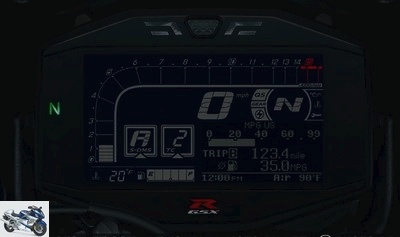
As on most motorcycles equipped with such a system, traction control reduces the power transmitted to the rear wheel first through the electronic accelerator and then by reducing the ignition advance, in cases extremes. It also acts as anti-wheeling, as is often the case with this type of system. Detachment of the front wheel during acceleration is however tolerated at the lowest levels of intervention (from 2), but they are quickly channeled by the electronics.
The level of traction control chosen is legibly listed at the bottom left of the new digital instrumentation, next to the engine mode selected (A the most responsive, B the intermediate and C adapted to difficult conditions). Note that the change from one map to another does not restrict the maximum power but acts only on the way it is delivered – more or less lively -, where it is about real driving modes on some of the rivals of the GSX-R with action on injection, ABS and traction control.
Other electronic novelties introduced only on the GSX-R1000R: a shifter which makes it possible to go up and down the gears without disengaging via an ignition micro-cut between 50 and 75 milliseconds and a starting aid system "Launch control", like on racing motorcycles. Activated from the left stalk, this device stabilizes the speed on the optimal range and then controls the acceleration for the quickest possible take-off, without unwanted nose-up. It is deactivated when the third is passed or when the throttle is cut.
We also note the introduction of the Suzuki Easy Start System and Low RPM Assist, two fairly practical everyday systems present among others on the new. The first allows you to start the engine with a single push to the starter, while the second automatically adds a little engine speed in first to avoid stalling.
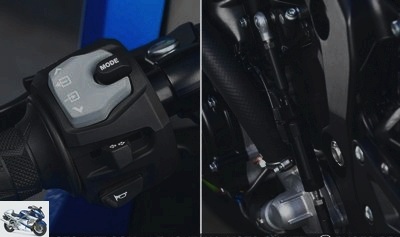
Finally, a last word on the new on-board console mentioned above, which offers much more information than in 2016 with better readability thanks to its white increments on a black background. Adjustable in six brightness levels, this instrumentation includes speed, engine speed, S-DMS engine mode, traction control level, shhiftlight, two trips, odometer, air and engine temperature , the time or the angle of inclination of the motorcycle (see the video dashboard on our).
We like to scroll through all this information via the left stalk, but also the presence of a fuel gauge at the bottom right, coupled with a consumption indicator: a rarity in the category, isn’t it the new CBR1000RR ?! A maintenance reminder is also integrated. Clearly, a good facelift for this bike which is also equipped with Full LED lighting, reinforced by position lights also entrusted to diodes on the R declination..
Related articles
-
2017 Suzuki V-Strom 1000 XT test: a super cost ! The Suzuki V-Strom 1000 , relaunched in 2013 after a career suspension in 2008 due to Euro 3 standards,…
-
2017 Kawasaki Z1000SX review: a super bike for the road Kawasaki is taking advantage of the changeover to Euro 4 to refine its Z1000SX on many fronts:…
-
Yamaha R1 and R1M 2015 test: with or without M, we like ! Yamaha’s brand new sports bike is currently landing in French dealerships. But it was on the…
-
2017 Yamaha YZF-R6 test: no, the Supersport is not dead Yamaha is the only major motorcycle manufacturer to keep its 600 cc sports car in its catalog in…
-
2017 Suzuki GSX-R1000R review: the beauty of Gex Driven by the most recent hypersport motorcycles for lack of developments over the past ten years or so,…
-
Africa Twin 2016 test: Honda takes over from the desert Basically, a trail is a motorcycle that is easy to handle and comfortable on all terrains. Honda…
-
Hypermotard 2013 test: the Italian renaissance Ducati is offering a brand new Hypermotard in 2013. 821 cc liquid-cooled engine, new chassis , advanced…
-
All Tests – GSX-S1000 Test: Suzuki is finally on target! – GSX-S1000: the MNC technical point
GSX-S1000 test: Suzuki finally hits the nail on the head ! It is obvious: Suzuki took too long to draw its first maxi roadster, leaving the field open to…
-
Test Triumph Tiger 1200 XRT and XCA 2018: ready for the road adventure Electric window, keyless start, hill start assistant, directional lights,…
-
2018 Honda Goldwing Touring test: more watts, less cotton wool On an exceptional motorcycle, exceptional measures: after 17 years without major…